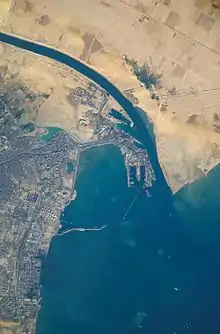Debouch
In the geography of rivers, streams, and glaciers, a debouch, or debouche, is a place where runoff from a small, confined space emerges into a larger, broader space. The term is of French origin and means to cause to emerge. The term also has a military usage.[1]

Geology
In fluvial geomorphology, a debouch is a place where runoff from a small, confined space emerges into a larger, broader space. Common examples are when a stream runs into a river or when a river runs into an ocean. Debouching can generate massive amounts of sediment transport. When a narrow stream travels down a mountain pass into a basin, an alluvial fan will form from the mass deposit of the sediment. The four largest rivers (the Amazon, the Ganges-Brahmaputra, the Yangtze and the Yellow) are responsible for 20% of the global discharge of sediment in to the oceans by debouches.[2]
Geography
In fluvial geography, a debouch is a place where a body of water pours forth from a narrow opening. Some examples are: where a river or stream emerges from a narrow constraining landform, such as a defile, into open country or a wider space; a creek joins a river; or a stream flows into a lake.[3]
Military
In military usage of debouch: as a noun, a fortification at the end of a defile is sometimes known as a debouch; and as a verb, soldiers emerging from a narrow space and spreading out are also said to "debouch". [4]
References
- Ma, Yanxia (2009). Continental Shelf Sediment Transport and Depositional Processes on an Energetic, Active Margin: the Waiapu River Shelf, New Zealand. pp. 2, 19.
- "debouch as a noun". Oxford English Dictionary. Retrieved October 10, 2012.
- Mitchell, Martha S. River Rules: The Nature of Streams. p. 5.
- "debouch as a verb". Oxford English Dictionary. Retrieved October 10, 2012.
External links
- "debouch". Merriam-Webster. Retrieved October 10, 2012.
